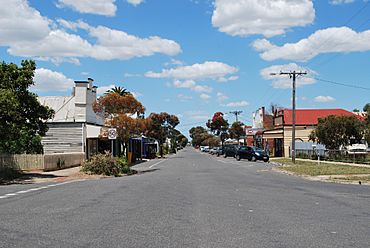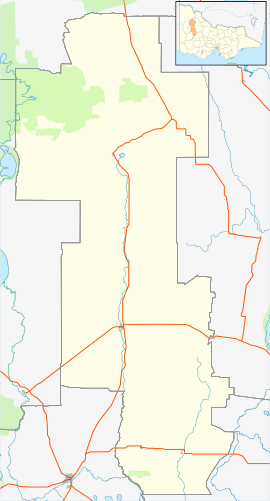Murtoa facts for kids
Quick facts for kids MurtoaVictoria |
|
|---|---|

McDonald Street, Murtoa
|
|
| Population | 865 (2016 census) |
| Postcode(s) | 3390 |
| Location |
|
| LGA(s) | Shire of Yarriambiack |
| State electorate(s) | Lowan |
| Federal Division(s) | Mallee |
Murtoa is a friendly town in Victoria, Australia. It's built around the beautiful Lake Marma. You can find it about 305 kilometres (190 miles) north-west of Melbourne, the state capital. Murtoa is part of the Shire of Yarriambiack area. In 2016, about 865 people lived here. It's also only about 30 kilometres (19 miles) from Horsham, a bigger city in the Wimmera region.
The name Murtoa is thought to come from an Aboriginal word. It means "home of the lizard." Murtoa's post office opened a long time ago, on August 1, 1874. Many of the first farmers in Murtoa were German immigrants. They came from South Australia because the Victorian government offered them good reasons to move here. Today, Murtoa has a very large grain storage area. It can hold up to 400,000 tonnes of grain. This makes it the biggest inland grain storage centre in Australia!
Contents
Discover Lake Marma and Rabl Park
Murtoa's Lake Marma is right in the middle of town. It has always been a wonderful place for wildlife. It's one of the prettiest lakes in the Wimmera region. The area around the lake is currently being improved. A special feature is the impressive rows of sugar gum trees. These trees were planted around the lake in the 1890s. You can also find a playground, BBQ areas, a rotunda, and big grassy spots nearby.
Just north of Lake Marma is Rabl Park. This park has a series of waterways and ponds. It's surrounded by attractive trees. Rabl Park also has a skate park and another playground. There's even an old railway walking bridge from 1896. You'll find more BBQ areas and large grassy spaces here too. Both lakes are great for fishing and other fun activities. They have lots of birds and nice walking paths around them. The Lake Marma area also has a good swimming pool. It's well-shaded by both trees and shade structures.
Explore the Murtoa Stick Shed
Murtoa is home to the world's largest building made in a rustic style. It's called the Murtoa No. 1 Grain Store. People often call it the "Stick Shed." During Second World War, Australia couldn't export wheat. So, a "temporary" grain shed was built. It was finished in late 1941 and early 1942. This huge shed is 270 metres (886 feet) long and 60 metres (197 feet) wide.
It was built using 560 un-milled tree trunks. These "sticks" are held up by iron rods. They are set into a concrete floor. The sticks support a roof made of corrugated iron. This amazing building looks a bit like a cathedral inside. It was last used to store wheat in 1989–90.
The Murtoa Stick Shed was recognized as a heritage site in 1990. In October 2008, the Victorian government gave money to fix it up. The Murtoa Stick Shed is now a popular place for tourists to visit. It's open Tuesday to Saturday from 10 AM to 12:30 PM. On Sundays, it's open from 10 AM until 2 PM. Make sure to give yourself plenty of time to enjoy this unique building. In October 2014, the Murtoa No. 1 Grain Store was added to the Australian National Heritage List.
The Murtoa No.1 Grain Store is an impressive and unusual example of Australian rural architecture; a form of design and construction rooted in the Australian traditions of bush ingenuity and the adaptation of traditional building techniques and materials. The corrugated iron and timber woolsheds across the Australian landscape are the most iconic depiction of this style of building ... The durability of this remarkable building is a testament to the bush skills and ingenuity of its builders and represents a rare and impressive example of Australian rural architecture and building technology to solve a difficult and large scale engineering problem.
Shopping and Local Businesses
Murtoa's main shopping area is on McDonald Street. It looks much like it did around 1910. It has timber shop fronts and verandah posts. You can find a large hardware store and an IGA supermarket here. There's also a licensed Post Office and a fuel station. Other businesses include a cafe, a Neighbourhood House, and an Op Shop. You might also find a furniture restorer and firearms supplies.
A big new Medical Centre is a key part of the town. It's located at the Wimmera Highway (Marma Street) intersection. It offers many health services and includes a Chemist's outlet. There's also a CBA Bank on Marma Street with an ATM. Marma Street also has a self-serve fuel station that only takes cards. On Duncan Street, you can find a butcher's shop. There's also a great delicatessen with hot or cold take-away food. The restored 1928 Mechanics Hall is nearby. Murtoa also has some larger local employers. These include GrainCorp, Schier Cabinet Makers, and Solomit Strawboard.
Schools in Murtoa
Murtoa has two schools for students. Our Lady Help of Christians (OLHC) is a Catholic primary school. It is located on Munro Street. Murtoa College is a state school that teaches students from Prep (the first year of primary school) all the way to Year 12. It is on Webb Street. There is also a kindergarten for younger children.
Sports and Recreation
The town has teams for Australian Rules football and Netball. They play in the Wimmera Football League. The Warracknabeal-Wimmera Racing Club holds horse races in Murtoa. They work with the local Murtoa/Marma Racing Club. There are two race meetings each year. These include the Murtoa Cup meeting in October.
Golfers can play at the 18-hole sand-scrape Golf Course. It belongs to the Murtoa Golf Club. You'll find it on Murtoa-Lubeck Road, just south of town. Murtoa also has excellent bowling greens and new tennis courts. There's a quality sports ground with new clubrooms and a netball court. An indoor stadium is located at Murtoa College.
Notable People from Murtoa
Murtoa has been home to some interesting people:
- John Cade - A famous psychiatrist, he was born in Murtoa in 1912.
- Amalie Sara Colquhoun - An Australian painter known for landscapes and portraits, she was born in Murtoa.
- Chris Crewther - He was schooled at Murtoa College from 1996 to 1999. He is a Member of the Victorian Legislative Assembly for Mornington since 2022. He was also a Federal Member of Parliament for Dunkley from 2016-2019.
- Hugh Delahunty - He was born and schooled in Murtoa. He was a Member of the Victorian Legislative Assembly from 1999 to 2014. He represented the Wimmera and Lowan areas.


